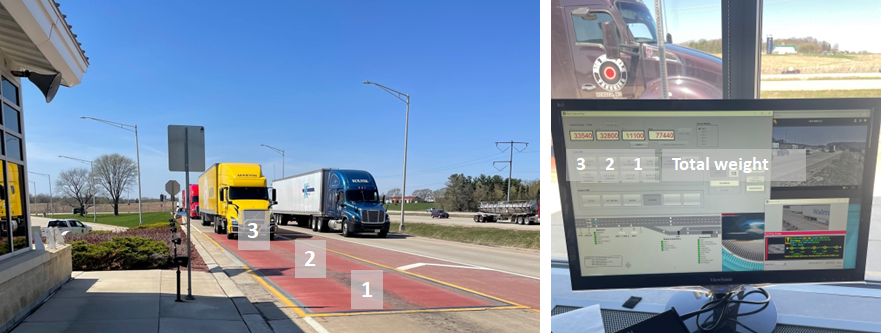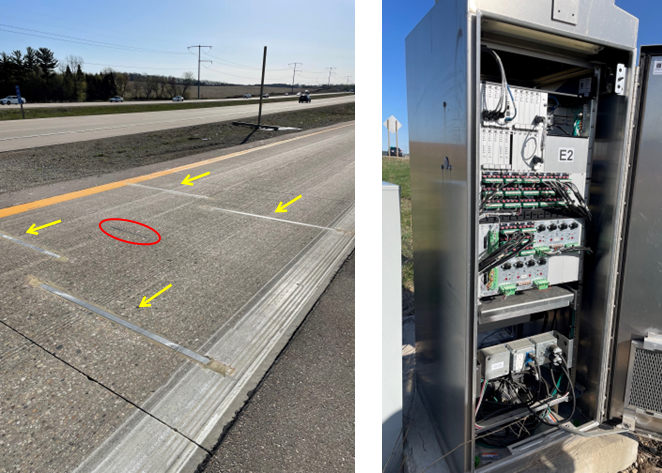Summary
Adhering to the commercial vehicle maximum weight limits established by state and federal authorities is critically important to protect our aging road transportation infrastructure including roadway surfaces, bridges, overpasses, and tunnels. Weigh-In-Motion (WIM) scale systems have weight sensors that are installed within the main roadways and ramps to directly measure vehicle weight while in the flow of traffic. These are commonly used to screen commercial vehicles or vehicle combinations (e.g., trucks with trailers) near state weigh stations for commercial weight enforcement. To ensure marketplace equity, it is imperative that an owner and/or operator of a commercial vehicle is also not improperly fined for an overweight violation that doesn’t exist. OWM has recently published a NIST Special Publication 2200-05 Certification Approaches for Weigh-In-Motion Systems in Law Enforcement Applications, which serves as guidance to all stakeholders involved with the application of WIM systems for direct enforcement of road weight limits.
Description
NIST OWM is responsible for promoting uniform standards of weights and measures to facilitate commerce. OWM works in cooperation with States and the private sector to develop uniform weights and measures laws, regulations, device requirements, and test procedures, including the published legal metrology code “Weigh-In-Motion Systems Used for Vehicle Enforcement Screening” in NIST Handbook 44 (Section 2.25). A proposal to the NCWM Specifications and Tolerances (S&T) Committee (See Item WIM-23.1 on the Committee’s 2023 Agenda) to convert the current code from Tentative to Permanent and to expand the code to include direct enforcement is currently under the review as a uniform standard for voluntary adoption by the States. To ensure a technically robust proposal, OWM provided recommendations that WIM systems are tested with the proposed WIM-23.1 test procedures and determined to be accurate to within the different tolerances specified.
To this end, OWM participated in a 2-day WIM system test demonstration (April 18 – 19, 2023) at a weigh station located near Madison, Wisconsin that was hosted by the Wisconsin Department of Agriculture, Trade, and Consumer Protection and the submitters of the WIM-23.1 proposal (New York City DOT, C2SMART, Kistler, and Maryland DOT). At this location, two WIM scale systems are used by the State of Wisconsin for screening purposes only (i.e., to screen commercial vehicles and vehicle combinations) for possible overweight violations. The demonstration provided an opportunity for all participants to witness the performance testing of these two different WIM systems and the associated weigh sensors by technicians representing the manufacturers of those systems.

It is imperative that any WIM system used for direct enforcement be able to provide accurate weight determinations of all components of the vehicle, including the axles, axle groups, and gross vehicle weight and throughout the entire duration of the enforcement evaluation. The first day of testing was devoted to using fully loaded trucks of three different types (FHWA Class 5, 6, and 9) and also included cursory testing using other vehicles with different axle configurations from the normal traffic stream. Vehicles having oversized loads, super-single tires on one or more axles, and trucks with other differing characteristics were also selected and weighed as part of this cursory testing. Both WIM systems performed exceptionally well. The second day was devoted to using empty trucks in dynamic testing and revealed a potential challenge of accurately measuring “bouncing” trucks while in motion over the WIM systems.

The demonstration proved very useful to observe the scale system equipment in use, better understand its operation with the influence of automatic calibration features and answer many initial questions about the operation and testing of these systems. As with most device tests, more new questions arose than were answered. Some pertinent questions remain on how best to deploy WIM scale systems in direct enforcement applications:
- Should automatic calibrations or “optimizations” be disabled to evaluate the full range of WIM system performance during tests, and if so, over an extended period?
- What is the optimum test speed, to both ensure accurate determinations and protect safety on high-speed freeways?
- Who will perform WIM system certifications and at what frequency to ensure they are aways accurate (i.e., to within the tolerances specified)?
- What are the appropriate traffic, environmental, and time duration conditions for robust WIM system testing?
- How will emergent weigh sensor technology be evaluated for adequate performance?
- What guidance should be provided to vehicle weight enforcement agencies regarding the establishment and implementation of violation thresholds to offset the large tolerances proposed?
OWM has recently published a NIST Special Publication 2200-05 Certification Approaches for Weigh-In-Motion Systems in Law Enforcement Applications, which serves as guidance to all stakeholders involved with the application of WIM systems for direct enforcement of road weight limits. This NIST SP 2200-05 publication also contains details from this recent demonstration and other points for the weights and measures community to consider as the proposal in S&T Item WIM 23.1 progresses, and how some of the submitters are planning to provisionally manage WIM-based enforcements as the code is still being developed.
We greatly appreciate the Wisconsin weights and measures staff and the proposal submitters organizing a field demonstration of a performance test using actual procedures included in the WIM-23.1 proposal and inviting all stakeholders to take part in the process.

